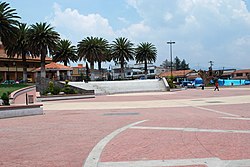Temoaya
| Temoaya | |
|---|---|
| Town & Municipality | |

Main plaza of Temoaya
|
|
| Coordinates: 19°28′07″N 99°35′36″W / 19.46861°N 99.59333°WCoordinates: 19°28′07″N 99°35′36″W / 19.46861°N 99.59333°W | |
| Country |
|
| State | State of Mexico |
| Founded | 1220 |
| Municipal Status | 1820 |
| Government | |
| • Municipal President | C. Enrique Valdes Garcia |
| Elevation (of seat) | 2,670 m (8,760 ft) |
| Population (2005) Municipality | |
| • Municipality | 77,714 |
| • Seat | 2,987 |
| Time zone | CST (UTC-6) |
| Postal code (of seat) | 50850 |
| Website | http://www.temoaya.gob.mx/ |
Temoaya is a town and municipality in Mexico State, Mexico. It is located 18 kilometres (11 mi) from Toluca and 85 kilometres (53 mi) from Mexico City. It is known for its large ethnic Otomi population, the Centro Ceremonial Otomí and its tradition of making Persian style rugs using Mexican designs.
The name “Temoaya” comes from the Nahuatl phrase “Temoayan” which means “place of descending.” The Aztec glyph which depicts the municipality shows footprints descending a mountain.
There have been humans in the Temoaya area since the prehistoric period. Remains from this time such as utensils, tools, human figures and mammoth bones have been found in various parts of the municipality. The Otomi have been living in this area since very far back in the pre-Hispanic era as one of the first ethnicities to live in the Valley of Mexico and northern Toluca Valley. There are archeological remains from this culture that date back at least as far as the pre-Classic era. Intense population of the Toluca Valley dates back to the 12th century, with the settlement of the Xiquipilco or Jiquipilco el Viejo site antecedent to modern Temoaya. No documents from this era survive but it is likely that modern Temoaya was the result of a division of Xiquipilco as it existed when the Aztecs came to the area at the end of the 15th century.
The Otomis of this region gained a reputation as fierce warriors over the pre-Hispanic period, fighting off the Toltecs, the Chichimecas under Xolotl and the Aztecs in the 15th century. Among the Aztecs, the Otomi also had a reputation of being barbarous, polygamous and sexually immoral. The Otomis of Xiquipilco fought against the Purépecha in 1462. Oral tradition states that until 1478, Tlilcuetzpalin, lord of the Otomi, defended the area from Aztec invasion, wounding Aztec emperor Axayacatl in battle. The Otomi here were conquered in 1486 by Ahuizotl, but chafed under Aztec rule, occasionally scheming with the Purépecha to try and wrest more autonomy.
...
Wikipedia
